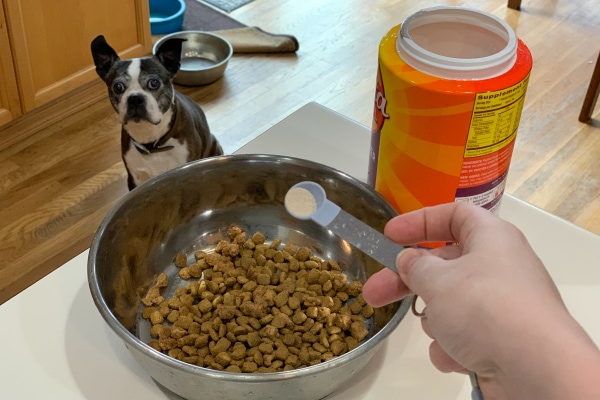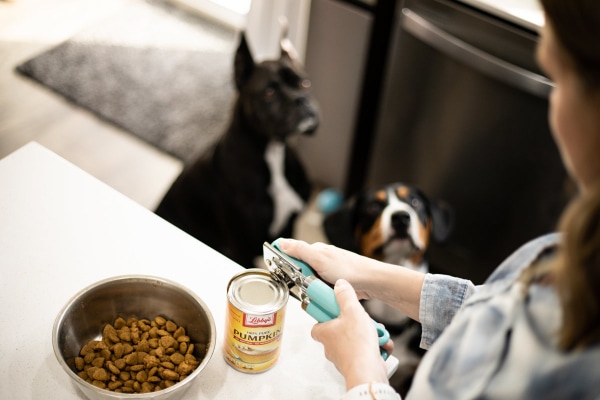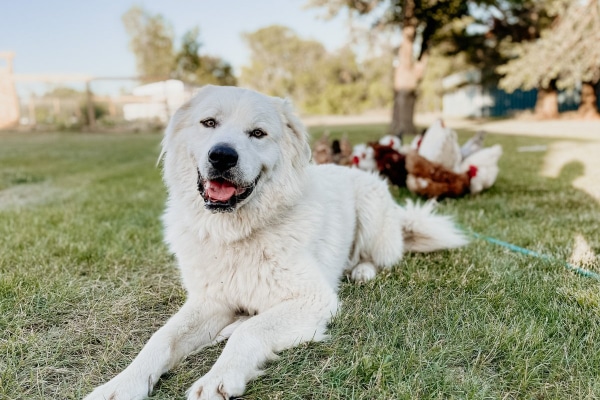Vets often recommend increased fiber for dogs with diarrhea, constipation, or anal gland issues, but not all fiber works the same way. Learn more about the types of fiber, benefits of fiber, and ways to add fiber to your dog’s diet from integrative veterinarian Dr. Julie Buzby.

If you watch TV regularly, you might recall a time when you saw a commercial for a fiber supplement like Metamucil or Benefiber. This might have led you to ask yourself, “Am I getting enough fiber in my diet?”
And then, especially if your furry friend was curled up on the couch with you, you might have begun to wonder “Do dogs need fiber too?” and “If so, how do I add fiber to my dog’s diet?”
As it turns out, fiber isn’t an essential nutrient for dogs, but it is definitely a helpful one. As such, it is a good idea to be aware of the types, benefits, and sources of fiber for dogs, especially if your dog is prone to fiber-responsive conditions like diarrhea, constipation, or anal gland problems.
What is fiber for dogs?
Dietary fiber is a non-digestible carbohydrate material that comes from edible plants. While fiber’s main claim to fame is its ability to help dog’s have regular bowel movements and firmer stools, fiber has many other benefits for dogs.
What are the types of fiber?
There are many types of dietary fiber that can be beneficial for our furry friends. But not all fiber is created equal. Depending on its type, it can have different effects on the GI system. To help make sense of how fiber can help your dog, we first need to dive into the specifics of how the different types of fiber work.
There are three criteria veterinary nutritionists use to characterize dietary fiber (and that help explain how the fiber acts in the body):
- Solubility—the ability to be dissolved or dispersed in water
- Viscosity—overall thickness when mixed with fluids
- Fermentability—the ability to be broken down by bacteria and other microorganisms
This first criterion—solubility—is the one we will use to start examining the fiber types.
Insoluble fiber
The group of insoluble fibers includes wheat bran, cellulose, and lignin. All of these fibers can add a bit of bulk to the stool. Plus, insoluble fiber works like a laxative because it irritates the lining of the intestines. This increases the wave-like movements of the intestines (i.e. peristalsis) so that water and foodstuffs move through the digestive tract quicker.
Soluble fiber
On the other hand, soluble fiber generally slows down GI transit time (i.e. the time it takes for ingesta to move through the GI tract) and does not bulk up the stools. To further discuss soluble types of fiber, let’s break them down based on fermentability.
Rapidly fermentable soluble fiber
Soluble yet non-viscous fibers like inulin and wheat dextrin can dissolve very quickly so that they create softer, less bulkier stools. This may be useful for dogs with constipation because smaller stools are easier to pass than bulkier ones. Also, the lower viscosity means less time accumulating in the stomach and intestines.
On the other hand, viscous soluble fibers include pectins and gums. These dietary fibers become more gel-like once they mix with water. Their higher viscosity slows the rate of passage through the digestive tract, while the gel-like form allows for easier movement of ingesta through the intestines.
Both of these fiber types have a higher fermentability. In other words, microorganisms can rapidly break them down into short chain fatty acids. This is good because short-chain fatty acids like butyrate, propionate, and acetate help prevent inflammation in the gut, promote healthy intestinal mucosa, and preserve the mucosal barrier (i.e. layer of protection) in the intestines.
An American Journal of Veterinary Research article helped demonstrate these benefits. It showed that dogs fed fermentable fiber (compared to those fed non-fermentable fiber) had a higher capacity for nutrient absorption and may have a lower risk of gut infections.
However, the downside of highly fermentable fiber is that it breaks down quickly. Thus, its beneficial effects on transit time and fecal consistency are shorter-lived than those of the slowly (or moderately) fermentable soluble fibers.
Slowly fermentable soluble fiber
For example, psyllium is also a soluble viscous fiber, but it is slowly fermented. This is helpful because its gel-like consistency will persist all the way to the colon, rather than being negated quickly from fermentation. Amazingly, psyllium can help soften stools for dogs with constipation. And it can also help firm up loose stools in dogs with chronic diarrhea.
How can fiber help my dog?
At this point, your eyes might be glazing over a bit from all this talk about the types of fiber. Here’s why this matters to you. The solubility, viscosity, and fermentability profile of the different fibers we just discussed make them well-suited for particular problems your dog might experience.
Fiber for anal gland problems in dogs
If you are wondering why your dog smells like fish or your dog is licking the base of the tail, impacted or infected anal glands could be to blame. Anal glands are tiny, marble-shaped sacs located within the wall of your dog’s anus. They secrete a foul-smelling fluid that, while not the most welcome addition to your home or clothing, helps dogs mark their territory. Plus, it is possible that anal gland fluid helps dogs defecate.

Anal glands can become impacted if they don’t empty well on their own. Normally, the physical pressure of the stool going past the anal glands will squeeze out some material. Thus, having bulkier stools should promote the regular emptying of these glands.
This is where insoluble fiber can come to the rescue. It is great at bulking up the stools, which is why products that promote anal gland health like Glandex contain the insoluble fiber cellulose.
Fiber for diarrhea in dogs
Most dogs will deal with a bout of diarrhea at least once in their lifetime, and it is a medical concern that veterinarians see amongst their patients almost every day. Diarrhea can have an acute onset, related to issues like stress or intestinal parasites. Or dogs may may suffer from chronic diarrhea that may be intermittent or persistent.
Acute diarrhea patients do well with soluble fibers with higher viscosity. One example is pectin, a rapidly fermenting soluble fiber that is one of the active ingredients in Vetoquinol’s Pro-Pectalin. While the pectin fiber can absorb water and help firm up stools, other ingredients like kaolin can reduce intestinal inflammation. Plus, its probiotic ingredients can support beneficial gut bacteria.
Patients with chronic diarrhea can benefit from soluble fiber products too. However, rapidly fermented fibers could contribute to more gas production. Thus, your veterinarian might recommend a soluble fiber like psyllium which has good viscosity but is only moderately (i.e. slowly) fermentable.
Metamucil, which is an over-the-counter fiber supplement, is often a good choice for these dogs with chronic diarrhea. It has psyllium as its active ingredient, and also contains some insoluble fibers for a more balanced effect.

Fiber for constipation in dogs
On the other side of the spectrum, dogs can occasionally become constipated. The stool may be dry, hard, and sometimes have a larger-than-normal diameter. All of these factors make it difficult for the dog to pass the stool, so dogs may go too long without pooping or strain to defecate.
The vet will probably need to use laxatives, enemas, and/or fluids to initially relieve severe constipation. Then fiber supplementation can be quite helpful in preventing future episodes of constipation. However, finding the right fiber type for constipated dogs can take a bit more trial and error.
Your vet may recommend using an insoluble fiber supplement to add bulk to the stools, promote intestinal motility, and draw water into the stools. This can make it easier for some dogs to poop. Other dogs may respond well to high fiber dog foods, many of which contain beet pulp as an ingredient. Beet pulp is a combination of soluble and insoluble fibers which can help increase colonic motility.
Alternatively, your dog could do best with a fiber supplement like Benefiber. It contains soluble non-viscous fibers like wheat dextrin to create less bulky stools. Finally, sometimes a longer-lasting soluble fiber supplement like psyllium does the trick.
Do healthy dogs need fiber too?
Up to this point, we have discussed how fiber can help dogs with medical problems. But it turns out that fiber is beneficial for all dogs. While fiber isn’t an essential nutrient for dogs, there’s plenty of evidence showing that it is important for intestinal (and especially colonic) health.
Fiber’s benefits include:
- Helping keep bowel movements formed and regular
- Preventing protein fermentation, thus avoiding the creation of toxic metabolites
- Helping beneficial bacteria compete against harmful bacteria
- Having prebiotic effects (i.e. providing food and energy to support the growth of beneficial gut bacteria)
- Increasing the production of short-chain fatty acids, which have anti-inflammatory properties
- Slowing down the absorption of glucose from the gut, which may reduce fluctuations in blood sugar levels after eating
With all these good properties, it makes sense that you would want to ensure your dog is getting enough fiber. However, this is where things can get a bit fuzzy.
How much fiber does a dog need?
Unfortunately, there is very little research that discusses how much fiber a dog needs every day to maintain a healthy digestive tract. This may be because there is a lot of individual variation. In other words, every dog is different, and will therefore have different fiber requirements. For example, a young, healthy puppy won’t need as much fiber as a senior dog with a history of constipation.

Additionally, the gut microbiome (i.e. the microorganisms) can influence how a dog responds to fiber in the diet. Some specialists suggest that microbiome read-outs (i.e. analyzing the specific gut bacteria present) may help quantify the amount of fiber needed. However, this isn’t a practical method to use for every dog at this point.
The other fuzzy aspect is the fact that there isn’t a consensus on the best type of fiber for dogs. It really depends on the individual dog and any illnesses her or she may have. And even then, as discussed in the constipation section of this article, much of fiber supplementation for dogs is trial and error.
The good news, though, is that a well-formulated commercial dog food is likely to have a sufficient fiber content for overall gastrointestinal health for most dogs.
How do I add fiber to a dog’s diet?
However, if you or your vet thinks your dog could benefit from added dietary fiber, there are several options for sources of fiber:
1. Dog food with high fiber
As I mentioned, the average commercial dog food tends to have adequate amounts of fiber. But there are also prescription diets with higher amounts of fiber in them. The foods usually have “high fiber” in the name of the product or will allude to the fiber contained within. The following is a short list of available prescription diets that are high in fiber:
- Royal Canin Gastrointestinal High Fiber
- Purina Pro Plan EN Gastroenteric Fiber Balance
- Hill’s Prescription Diet Gastrointestinal Biome Digestive/Fiber Care
- Hill’s Prescription Diet w/d
Trying a prescription dog food with high fiber is one of the easiest ways to increase fiber intake. The veterinary nutritionists who formulated the food have already taken care of figuring out the types and amount of fiber to add. And the fiber is contained within the food, so all you have to do is feed your dog.
Plus, dogs usually like these foods. This is helpful because when you supplement fiber in a powdered form or try to give other sources of fiber for dogs, sometimes it can interfere with palatability. This may make your pup less likely to want to eat.
2. High fiber foods for dogs
Alternatively, if your dog just needs a small amount of fiber, there are some fiber rich foods that you can offer as an occasional high fiber dog treat. Human foods that are high in fiber like green beans and sweet potatoes are good sources of fiber and fine to give in small quantities. But on a safety note, only give your dog small, cooked portions of sweet potatoes. Larger, uncooked, or more solid portions can be a choking hazard or obstruct the GI tract.
Canned pumpkin for dogs is another way to naturally add fiber to a dog’s diet. It provides a nice combination of both soluble and insoluble fiber. Plus, you can use it to make tasty high-fiber treats like my pup-kin holiday dog treats. Do not give your dog pumpkin pie filling, though. It may contain spices or fake sugars like xylitol, which is toxic for dogs.

Keep in mind that these treats should never account for more than 10% of your pup’s daily allotment of calories. Also, remember that while these foods are a nice way to add fiber to a dog’s diet naturally, they aren’t going to contain nearly as much fiber as high fiber dog foods or fiber supplements.
3. Fiber supplements for dogs
Some dogs with constipation, diarrhea, or anal gland issues may need more fiber than fiber-rich foods can provide. Aside from feeding a high fiber commercial food, another way to increase fiber intake is to add in a fiber supplement. As mentioned, these supplements do sometimes have issues with palatability for some dogs. However, other dogs don’t seem to mind them.
Your vet may recommend using a human fiber supplement or a dog-specific one.
Useful over-the-counter fiber supplements sold for humans include Metamucil and Benefiber. Of the two, Metamucil has more fiber per serving.
As a word of warning, when buying human fiber supplements, avoid the “sugar free” varieties, wafers, gummies, and flavored options because they may contain inactive ingredients that are harmful for dogs. Always check the label carefully to make sure it does NOT include the sugar-substitute called xylitol (i.e. birch sugar). Xylitol is very toxic for dogs.
Both Metamucil and Benefiber come in flavorless varieties, which are usually free from dangerous ingredients (but it is still best to check the label). They are also typically more palatable and easier to add to your dog’s diet. To help the powdered supplement adhere to regular food, try sprinkling it with water. However, too much water will make it gooey and unappetizing.
Commercial fiber supplements for dogs are also available. No Scoot chews and Glandex chews are the best high-fiber dog treats for anal gland problems because their ingredients help with bulkier stools. Bernie’s Perfect Poop is another good source of fiber for dogs, combining pumpkin with probiotics and prebiotics. Keep in mind, though, that supplements are not vigorously tested in the same way as medications. Ensure you ask your vet for advice before starting any supplementation regimen.
Additionally, it is best to consult your vet anytime you think your dog might need some added fiber. That way, he or she can help point you toward the right product. Plus, your vet can talk to you about how to monitor your dog’s response and watch for adverse reactions.

Can too much fiber cause problems?
It is unusual for dogs to develop severe side effects from fiber supplementation (be it via high-fiber dog food, fiber-rich foods, or fiber supplements). However, mild to moderate symptoms from too much fiber are possible.
When using soluble fiber products like Metamucil, too much of it can lead to diarrhea. Also, excess amounts of insoluble fibers like cellulose can worsen constipation, and too much of the rapidly fermentable fiber types can increase gas production (and thus, flatulence). If you notice these symptoms, please consult your veterinarian.
Additionally, large amounts of all fiber types can inhibit digestive enzymes from metabolizing certain nutrients. Or they may dilute out the energy and nutrient content of the food to the point where the dog can’t consume enough to meet his or her needs. This especially can be a problem in young dogs who still have growing to do.
Finally, adding fiber to a dog’s food can also increase the number of bowel movements that he or she has per day. Even though this isn’t detrimental to your pup’s health, it can be awfully inconvenient if you’re having to take them outside to poop multiple times a day!
Does your dog need more fiber? Ask your vet
As you have learned, there can be many benefits to supplementing fiber in your dog’s diet. This is especially true if your dog struggles with anal gland problems, diarrhea, or constipation. Also, while it isn’t strictly necessary for them, even healthy dogs can experience some gut-health benefits from added fiber.
If you are wondering if you should add some fiber to your dog’s diet, your veterinarian is the perfect person to talk to. He or she knows your dog’s medical history and can make some recommendations for the best fiber source and starting amount. Then, by staying in contact with your vet, you can settle on the correct balance of fiber to keep your dog in optimal health.
Do you add fiber to your dog’s diet?
Please comment below.


I have a 14 month old, intact male Dalmatian.
His morning poops initially are solid but he has always continued to strain until they become liquid. His evening poops begin as “soft serve” and again the longer he tries to go, the more liquid they become.
He’s been on the lower/controlled copper intake kibble that his breeder feeds all of their Dalmatians. It is not a hepatic prescription brand. He also takes a prebiotic every morning with his first meal. Like in this article, his vet recently recommended that I add 3-4 tbsp of pure pumpkin at his dinner and that is improving the morning poops. His vet also suggested switching to a high fiber diet/kibble but all of them have higher copper levels than his current kibble.
I’ve heard that adding crushed bran flakes to each meal will help firm up a dog’s poops. Based on the above, I presume bran is an insoluble fiber. In the article, you suggest unflavored Metamucil or Benefiber. For each of these 3 supplements, what is the recommended dose per 10 lbs. of dog weight? Maybe I missed it above for the latter 2, but I’m not seeing how much is a typical or starting dosage, and what’s a maximum dose?
Thanks
Hi TommyBoy,
I understand your concern for your young Dalmation and think it is great you are advocating for his health and well-being. I have never tried to use bran flakes as a fiber source for dogs so I really have no idea how much they would need to consume or if it would even be effective. For Metamucil and Benefiber I usually start with 1 tablespoon a day. The dosing for these has a very wide range so it can be adjusted as needed under the supervision of your vet. Here is a link to another article with more information: Metamucil for Dogs: Can I Safely Give It to My Dog?
As far as a high fiber diet is concerned, just because the copper levels are higher doesn’t necessarily mean they are too high. What level are you trying to maintain or stay under? Hoping you can find what works best for your pup. Take care and keep up the good work!
My 65lb pit bull mixed breed dog eats the same breakfast i do. Steel cut oats with blueberries, ground flax, and a little homemade nut milk with a chunk of yam / sweet potato. We love it and it’s a great energetic way for us to start the day for both of us.
Poops are A+++!
Hi Howard,
That sounds amazing! What a lucky pup!
Sounds great. And, perhaps let folks who might want to also do this, to research carefully which nut milks are safe for dogs? (For example, I drink macadamia milk, which is toxic for dogs!)
Hi Sarah,
YES! Thank you for bringing up this important topic!
I noticed both my 10 year old Golden Retriever and my 9 year old German Shepherd lately straining a bit, having smaller poops. I do add pure pumpkin, oatmeal, grated apples and carrots, sometimes celery
Hi Teri,
These are all great sources of fiber and nutrients. If you are noticing changes in your dogs’ bowel movements and have not recently changed their diet, it may be a good idea to have them examined by your vet. They will probably want to check a fecal sample, so make sure you save one or keep them from using the bathroom just prior to your visit!